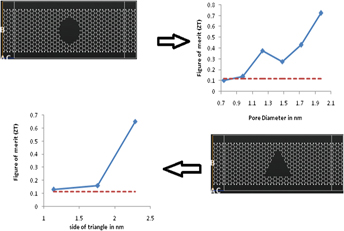Article contents
Influence of the pore shape and dimension on the enhancement of thermoelectric performance of graphene nanoribbons
Published online by Cambridge University Press: 02 February 2017
Abstract

There is a need to discover new thermoelectric materials that can convert waste heat into electrical energy. In this paper, study has been done to observe the effect of shape and dimension of nanopores embedded in graphene nanoribbons (GNRs) as to tune their thermoelectric performance that can lead to enhancement of thermoelectric figure of merit (ZT). It is observed that incorporation of pores in GNRs greatly reduces the thermal conductivity. Although the Seebeck coefficient decreases with the introduction of the pore while the conductance depends upon the pore shape, the decreasing trend in thermal conductivity leads to enhancement of thermoelectric performance. The aim of this work is to study the effect of various circular and the triangular shaped dimensions so as to tune the pore to its optimal dimension that would enhance the overall thermoelectric efficiency. Ballistic transport regime and semiempirical method using Huckel basis set is used to obtain the electrical properties while the Tersoff potential is used for the phononic system.
- Type
- Articles
- Information
- Copyright
- Copyright © Materials Research Society 2017
Footnotes
Contributing Editor: Mauricio Terrones
References
REFERENCES
- 8
- Cited by





